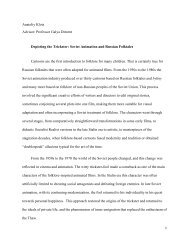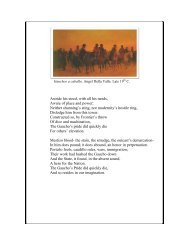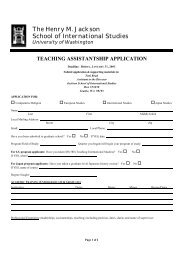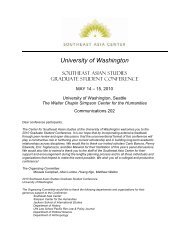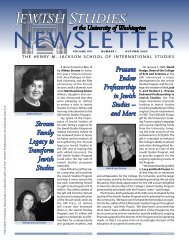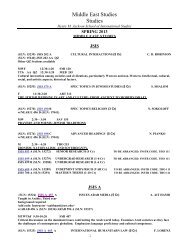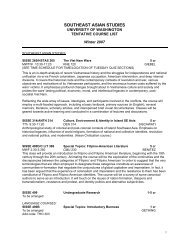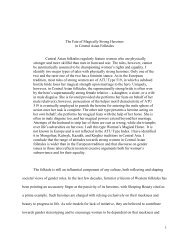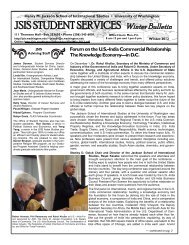Cobblestone Publishing Kamishibai for Kids - Jackson School of ...
Cobblestone Publishing Kamishibai for Kids - Jackson School of ...
Cobblestone Publishing Kamishibai for Kids - Jackson School of ...
Create successful ePaper yourself
Turn your PDF publications into a flip-book with our unique Google optimized e-Paper software.
National Consortium <strong>for</strong> Teaching about Asia (NCTA) Classroom Materials Descriptions<br />
Along the Silk Road $74.95 – Middle <strong>School</strong> to Secondary<br />
This unit was adapted from two previous units, SPICE’s Along the Silk Road (1993) and Silk Road<br />
Encounters (2001) published by the Silk Road Project and the Asia Society. The “Silk Road” refers to a<br />
series <strong>of</strong> routes that crisscrossed Eurasia from the first millennium BCE through the middle <strong>of</strong> the second<br />
millennium CE. Each lesson focuses on a specific aspect <strong>of</strong> the Silk Road, from language to art to music.<br />
While a lesson can be taught in isolation, it is suggested that lessons be taught in the order they appear,<br />
as later lessons build on earlier ones. There are eight lessons. Lesson One introduces students to the<br />
geography <strong>of</strong> the Silk Road. Lesson Two examines the history <strong>of</strong> the Silk Road. Lesson Three focuses on<br />
the different languages and the communication challenges <strong>of</strong> traders and travelers. Lesson Four<br />
introduces the dynamics <strong>of</strong> trade. Lesson Five introduces the major belief systems (religions and<br />
philosophies) and their tenets. Lessons Six and Seven look at art and music. Lesson Eight investigates<br />
the topic <strong>of</strong> migration over three time periods. This unit includes a CD <strong>of</strong> audio files, images, maps,<br />
transparencies, and video files. 2006.<br />
Choices in International Conflict: With a Focus on Security Issues in Asia $31.95 – Secondary to<br />
Community College<br />
This curriculum unit spans a large part <strong>of</strong> Asia with its lessons relating to military buildup, political policy,<br />
and security issues. Relevant to the study <strong>of</strong> China is Lesson Three, “The 1996 Taiwan Strait Crisis.”<br />
This lesson alone includes nine handouts, four editorials, four political cartoons, a transparency, and<br />
materials to prepare the teacher <strong>for</strong> the lesson. Relevant to the study <strong>of</strong> Japan is Lesson One, “The U.S.-<br />
Japan Security Alliance,” Lesson Two, “U.S. Military Bases in Okinawa,” and Lesson Six, “The Russo-<br />
Japanese “Northern Territories” Dispute.” One lesson focuses on the Korean peninsula, and there is one<br />
lesson on Cambodia. Each lesson incorporates handouts, transparencies, political cartoons, reprints <strong>of</strong><br />
editorials, and materials <strong>for</strong> the teacher. 1998.<br />
Contagion in the East: A Look at the 1997-98 Asian Financial Crisis $25.95 – Upper Secondary to<br />
Community College<br />
This three-lesson unit will introduce students to a handful <strong>of</strong> economic basics and help them understand<br />
East Asian emerging economies and the IMF. How do economic fluctuations in Asia affect us all? 2000.<br />
Feeding a Hungry World: Focus on Rice in Asia and the Pacific $64.95 – Middle <strong>School</strong> to<br />
Community College<br />
This comprehensive curriculum unit explores the cultural, economic, environmental, and political aspects<br />
<strong>of</strong> rice production in Asia. While no lesson focuses specifically on China, China is well-represented in<br />
almost every lesson. Lessons include “Biodiversity in Rice Production,” “Rice Policy and the Stages <strong>of</strong><br />
Agricultural Development,” and “Population Growth and Rice.” Incorporates a wealth <strong>of</strong> handouts and<br />
resources. 1995.<br />
Geography and the Human Experience $44.95 – Middle <strong>School</strong> to Secondary<br />
This unit introduces students to a broad range <strong>of</strong> topics and activities that are essential to the study <strong>of</strong><br />
geography. These issues include map analysis and comparison, migration and perceptions <strong>of</strong> region,<br />
interactions between humans and the environment and their implications, urban growth and energy<br />
consumption, political divisions <strong>of</strong> the earth, and economic interdependence around the world.<br />
Throughout this unit, students refer to and use a mapmaking tool on the Internet that allows them to<br />
select myriad geographical in<strong>for</strong>mation to create their own maps. Students also learn about geographical<br />
issues around the world through case studies from 12 countries including several on East Asia. 2004.<br />
Mapping Asia $21.95 – Middle <strong>School</strong> to Secondary<br />
This curriculum unit has been designed to serve two major functions: to teach about the basic physical<br />
and political geography <strong>of</strong> Asia, and to review fundamental geographical concepts and vocabulary in an<br />
Asian context. Includes handouts, worksheets with answer keys, pages which are suitable <strong>for</strong> making<br />
transparencies, teaching guides, and appendices. Lessons include “About Climate,” “What is Asia,” and<br />
Learning the Physiographic Features <strong>of</strong> Asia.” 1994.<br />
8



